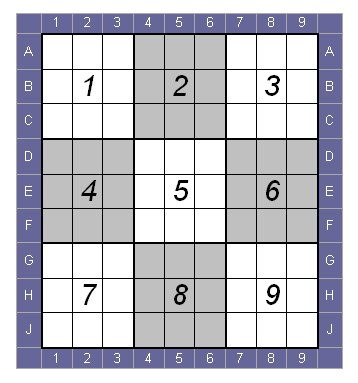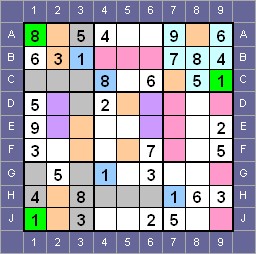|
|
Getting Started with Sudoku...
"Before
We Explore the Sudoku Solving Strategies, Let's Cover the Basics!"
I want to define a system to help identify
individual cells and the relationship between cells.
The Sudoku board (also referred to as the Grid) consists of Rows,
Columns, and Boxes, each containing nine Cells (or squares).
I have given each row, column, box, and cell an identifier to allow me
to refer to specific locations on the Sudoku board. Rows are identified
from top to bottom, from A to J. Columns are numbered from left to
right, from 1 to 9. Boxes are numbered from 1 to 9 as top left, top
center, top right, middle left, middle center, middle right, bottom
left, bottom center, and bottom right.
The Sudoku Board (Grid)

Each cell can be identified as a two-digit alphanumeric that combines
the row letter followed by the column number. For example, the cells in
the top row are A1, A2, A3, etc. The cells in the bottom row are J1, J2,
J3, and so on.
Definitions
As the discussion moves into more complex strategies, I will need to
identify relationships between cells. The following definitions will be
used:
Cell – refers to the individual squares on the Sudoku board
Group – cells in a row, column, or box. There are nine rows, columns,
and boxes on the board, thus 27 groups.
Family – all cells that appear in the same row, column, or box as the
target cell. Each cell has 20 family members, not including itself.
Candidates – remaining possibilities for a cell
Pencilmarks – handwritten notes placed in cells to identify the remaining
possibilities for a cell; used as a synonym for candidates.
Board position – the arrangement of filled and unfilled cells on the
board at any given time
Sudoku Logic
A Sudoku puzzle is always solved using a logical process of elimination,
or exclusion. Each number that can be definitively assigned to a cell is
an indication that all other possible numbers have been excluded.
The rules of Sudoku require that each row, column, and box contain the
numbers 1 through 9 with no duplication of a number within the group.
The rules enable logical deductions to be applied to solve the puzzle.
This leads to a surprising number of strategies that can help solve the
puzzle.
The first approach to the exclusion process is to start with a target
cell and exclude numbers until only one possible number remains to fill
that cell. This is the most common method employed by beginning puzzle
solvers.
The second approach is to select a target number (from 1 to 9) and
exclude cells within a row, column, or box until only one cell remains
that can hold the target number. The method is more sophisticated and is
extremely powerful. Both approaches will be used extensively in the
solving process.
|
|

"I just found
your website this afternoon and I'm thrilled! The explanations I have
read so far are very clear - much better than I have seen elsewhere -
and the material seems well organized. I am very new to Sudoku (started
in August, 2011) and eager to learn all the strategies."
Joy P. Olson, Minneapolis MN
* * *
"I have sampled
your book and I like the number of techniques it
covers, you can't buy a book that covers the level
of techniques that this book covers, this was the
book that I was looking for."
Dan Skillin, UK
* * *
"I was fortunate to
come across your website when I was using a solver to try to figure out
the best techniques to use when solving classic Sudoku.
I have been trying to come across a clear explanation for solving the
daily Sudoku puzzle in the New York Times. After practicing the
techniques given by your site, I have been able to successfully solve
the difficult level of the daily puzzle. Thank you for your assistance
and hard work."
-Joseph Kosinski, Auburn NY
* * *
"I just found
your website. If still available, I would love to
have your book. I read some of the material you
published and my first impression is that your
explanation of basic strategies is more reader
friendly than many others I have encountered. Thank
you for writing this, it was much needed."
R Valdes
* * *
"...your
explanations (and diagrams) have been easier for me to follow than the
ones at sudokuwiki.org."
-Ken Brown
|
|
Attention
Sudoku Enthusiasts!
In Less Than 60 Seconds
You Will Discover...
"The Ultimate
Sudoku Strategy Book"

How To
Solve All Levels of Sudoku Puzzles Quickly & Easily!
My book, "Sudoku for
Everyone: The Easy to Understand Sudoku Strategy Guide for
Beginners to Experts" is perfect for Sudoku puzzles solvers who are "stuck" and can't seem to
move to the next level.
Are you
interested in becoming a Sudoku master, able to impress your
friends, family (and yourself) with your ability to solve Sudoku puzzles quickly and easily?
Get Your Book
Today!
|
|
|
